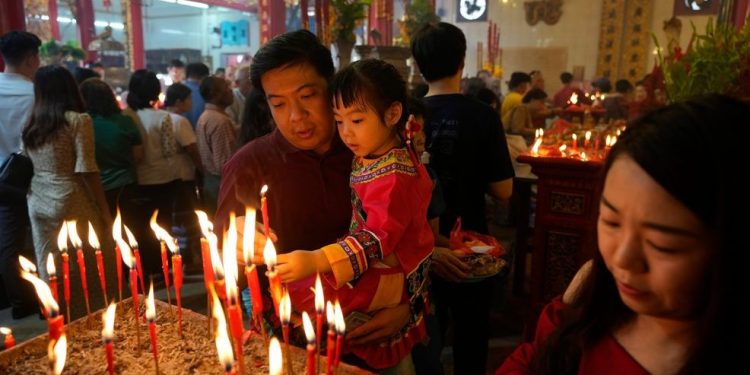Beijing – Firefighters jumped, incense was offered to the temples and dancers on Wednesday in Asia and further while millions of people in the world celebrated the Lunar New An.
From Beijing to Havana, the holidays – known as the spring festival in China, Tet in Vietnam and Seollal in Korea – is a major festival celebrated in many countries. Wednesday marked the start of the year of the snake, one of the 12 animals of the Chinese zodiac.
Crowds of people in jackets filled a Beijing park for a “temple fair” on a sunny but cold day. Some have sounded bells and launched parts in containers in the shape of good luck, while others ate traditional snacks of food stands and took photos with a person disguised in God of the wealth.
The Lunar New Year is the time to wish good luck and prosperity during the coming year and for others.
“Last year was very busy for me because I had to take care of my child and my work,” said Beijing resident Jiang Hecang. “During the year of the snake, I want my child to grow healthy and my work can remain stable. Then, I can be quite happy.”
In Malaysia, the crackling of the firecrackers welcomed the new year outside the temple of Guan Di in the capital, Kuala Lumpur, followed by lion dances at the rhythmic rhythm of drums and small cymbals.
The ethnic Chinese held incense sticks in front of them and bowed several times inside the temple before sticking the incense in gold color pots, smoke rising from burning points. Temple Tai Sin Taoist Wong Sin in Hong Kong with the aim of being among the first to put incense sticks in the stands opposite the main hall of the temple at 11 p.m.
“I hope that my family is blessed. I hope my business will work well. I pray for my country and I wish people peace. I hope this year to come is a better year, “said Ming So, who visits the temple every year for the end of the evening ritual.
Online, Google joined the festivities on Wednesday by showing the play of classic snakes on its home page.
Many Chinese people working in big cities go home during the eight -day national holiday in what is described as the largest annual humanity movement in the world. The exodus transforms Beijing, the Chinese capital, into a little a ghost city, with many closed shops and the normally congested roads and the metro.
Traditionally, Chinese families come together for a festive dinner at home the evening of the New Year. In the New Year Lunar, many visit the temples to pray and attend the living room salons to watch performance and buy snacks, toys and D Other trinkets.
“I bring my children here to discover the atmosphere, because the New Year’s atmosphere … fades,” said Wang Xinxin, resident of Beijing, during a Temple Fair in Ditan Park, L ‘Old Temple of the Earth in the Ming and Qing dynasties.
“Children and mine do not have much ideas what New Year like Beijing like, but here we can always see elements,” said Wang.
The government has reduced unofficial celebrations, major cities prohibiting noisy firecrackers which once reflected around Beijing and left blocks wrapped in smoke.
Many Chinese take advantage of the prolonged holidays to travel to the country and abroad. Ctrip, an online reservation agency that operates Trip.com, said that the most popular destinations abroad this year are Japan, Thailand, Hong Kong, Malaysia, Singapore, Australia, States -Unis, South Korea, Macao and Vietnam.
In Moscow, the Russians applauded, greeted and took photos of smartphones of drummer, costume dancers and long figures of dragon and snakes held in the air in a colorful procession that launched a 10 -day lunar festival on Tuesday evening.
Chinese and Russian governments have deepened links since 2022, in part to repel what they consider as American domination of the world order.
The visitors shouted “Happy New Year” in Russian and expressed their joy at being able to discover Chinese food and culture in Moscow, including folk performance and stands selling snacks and works of art.
The small Chinese community of Cuba celebrated the Lunar New Year Tuesday evening with a parade of lanterns and brilliant dragons fraying its path in the narrow streets of the Chinese district.
The island once housed one of the largest and oldest Chinese communities in the Americas. Now, a much smaller community celebrates the long holidays with a Cuban touch, mixing rum and cigars with traditional Chinese cuisine.


